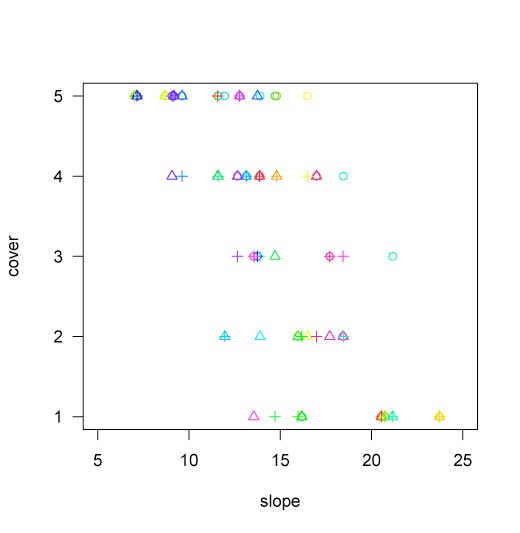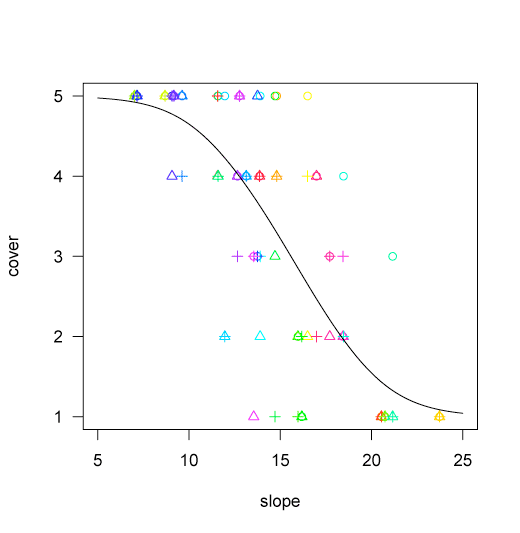R: drmを使ってみる [統計]
順序尺度の目的変数を解析する累積ロジットモデル。drmを使ってみた。混合モデルを解析できる。
こういうデータを用意。

# inverse logit
invlogit <- function(x) exp(x)/(1+exp(x))
set.seed(123)
plot <- 1:30
n.plot <- length(plot)
time <- 1:3
n.time <- length(time)
data <- expand.grid(plot = plot, time = time)
slope <- rgamma(n.plot, shape = 15^2/5^2, rate = 15/5^2)
data$slope <- rep(slope, n.time)
ranef.plot <- rnorm(n.plot, 0, 1)
ranef.time <- rnorm(n.time, 0, 1)
logit.c1 <- 7.5 - 0.5 * slope +
ranef.plot[data$plot] + ranef.time[data$time]
data$c1 <- rbinom(n.plot * n.time, 4, invlogit(logit.c1)) + 1
col <- rainbow(n.plot)
plot(c1 ~ slope, data = data, pch = time, col = col[plot],
las = 1, ylab = "cover", xlim = c(5,30))
drmで解析する。nlmで尤度を最大にしているようだ。(追記) marginal regressionという方法を使用しているようだ。デフォルトの初期値ではうまくいかないことがある。
library(drm)
fit <- drm(c1 ~ slope + cluster(plot) + Time(time),
data = data,
start = c(3, 4, 5, 6, -1))
summary(fit)
結果
Call:
drm(formula = c1 ~ slope + cluster(plot) + Time(time), data = data,
start = c(3, 4, 5, 6, -1))
Coefficients:
Value Std. Error z value
(Intercept)1 -10.9588098 1.39089022 -7.878990
(Intercept)2 -9.4931094 1.26458408 -7.506903
(Intercept)3 -8.4885088 1.18236774 -7.179246
(Intercept)4 -6.7823769 1.05836034 -6.408382
slope -0.5746348 0.07889966 -7.283109
Residual deviance: 191.666 AIC: 201.666
Convergence code 1 in 27 iterations (See help(nlm) for details)
Correlation of Coefficients:
(Intercept)1 (Intercept)2 (Intercept)3 (Intercept)4
(Intercept)2 0.965
(Intercept)3 0.952 0.976
(Intercept)4 0.931 0.945 0.956
slope 0.965 0.971 0.970 0.958
Gelman & Hill (2007) を参考に、期待値の曲線を重ねてみる。
coef <- fit$coefficient
x <- seq(5, 30, 0.1)
expected <- 5 * invlogit(coef[5] * x - coef[4]) +
4 * (invlogit(coef[5] * x - coef[3]) -
invlogit(coef[5] * x - coef[4])) +
3 * (invlogit(coef[5] * x - coef[2]) -
invlogit(coef[5] * x - coef[3])) +
2 * (invlogit(coef[5] * x - coef[1]) -
invlogit(coef[5] * x - coef[2])) +
1 * (1 - invlogit(coef[5] * x - coef[1]))
lines(x, expected)

タグ:累積ロジットモデル





コメント 0